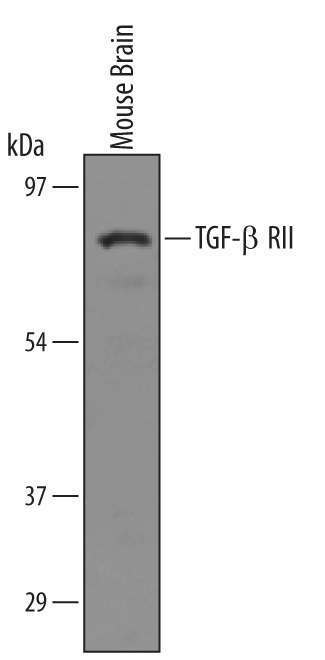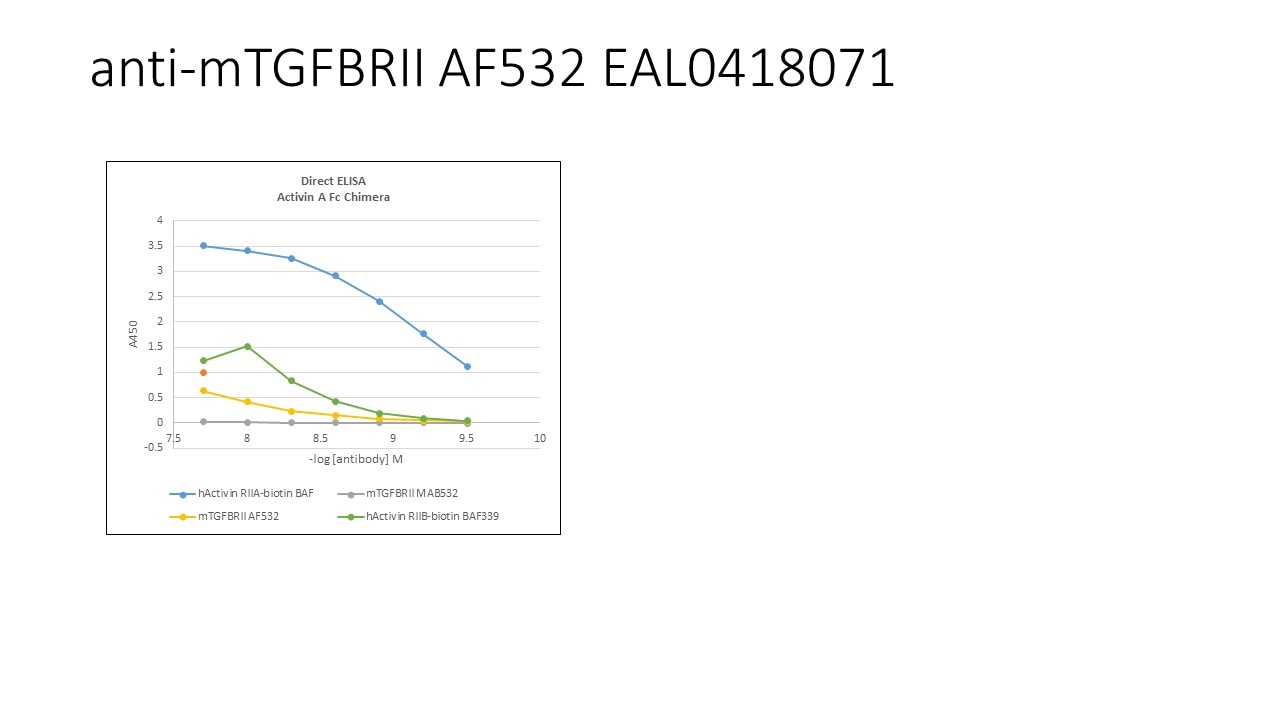Mouse TGF-beta RII Antibody Summary
Ile24-Asp184
Accession # Q62312
Applications
Please Note: Optimal dilutions should be determined by each laboratory for each application. General Protocols are available in the Technical Information section on our website.
Scientific Data
 View Larger
View Larger
Detection of Mouse TGF-beta RII by Western Blot. Western blot shows lysates of mouse brain tissue. PVDF membrane was probed with 2 µg/mL of Goat Anti-Mouse TGF-beta RII Antigen Affinity-purified Polyclonal Antibody (Catalog # AF532) followed by HRP-conjugated Anti-Goat IgG Secondary Antibody (HAF019). A specific band was detected for TGF-beta RII at approximately 75 kDa (as indicated). This experiment was conducted under reducing conditions and using Immunoblot Buffer Group 8.
Reconstitution Calculator
Preparation and Storage
- 12 months from date of receipt, -20 to -70 °C as supplied.
- 1 month, 2 to 8 °C under sterile conditions after reconstitution.
- 6 months, -20 to -70 °C under sterile conditions after reconstitution.
Background: TGF-beta RII
Most cell types express three sizes of receptors for TGF-beta. These are designated Type I (53 kDa), Type II (70 - 85 kDa), and Type III (250 - 350 kDa). The Type III receptor, a proteoglycan that exists in membrane-bound and soluble forms, binds TGF-beta 1, TGF-beta 2, and TGF-beta 3 but does not appear to be involved in signal transduction. The Type II receptor is a membrane-bound serine/threonine kinase that binds TGF-beta 1 and TGF-beta 3 with high affinity and TGF-beta 2 with a much lower affinity. The Type I receptor is also a membrane-bound serine/threonine kinase that apparently requires the presence of the Type II receptor to bind TGF-beta. Current evidence suggests that signal transduction requires the cytoplasmic domains of both the Type I and Type II receptors.
The recombinant soluble TGF-beta Type II receptor is capable of binding TGF-beta 1, TGF-beta 3, and TGF-beta 5 with sufficient affinity to act as an inhibitor of these isoforms at high concentrations. The soluble receptor also binds TGF-beta 2, but with an affinity at least two orders of magnitude lower. Binding of TGF-beta 1, TGF-beta 3, and TGF-beta 5 to the soluble TGF-beta Type II receptor can also be demonstrated by using the soluble receptor as a capture agent on ELISA plates and this observation has been used as the basis for the development of immunoassays for these isoforms of TGF-beta.
Product Datasheets
Citations for Mouse TGF-beta RII Antibody
R&D Systems personnel manually curate a database that contains references using R&D Systems products. The data collected includes not only links to publications in PubMed, but also provides information about sample types, species, and experimental conditions.
7
Citations: Showing 1 - 7
Filter your results:
Filter by:
-
TGF? Signaling Dysregulation May Contribute to COL4A1-Related Glaucomatous Optic Nerve Damage
Authors: Mao, M;Kuo, YM;Yu, AK;Labelle-Dumais, C;Ou, Y;Gould, DB;
Investigative ophthalmology & visual science
Species: Transgenic Mouse
Sample Types: Tissue Homogenates
Applications: Western Blot -
Development of syngeneic murine cell lines for use in immunocompetent orthotopic lung cancer models
Authors: K Nolan, G Verzosa, T Cleaver, D Tippimanch, LN DePledge, XJ Wang, C Young, A Le, R Doebele, H Li, SP Malkoski
Cancer Cell Int., 2020-08-28;20(0):417.
Species: Mouse
Sample Types: Cell Lysates, Whole Cells
Applications: Western Blot -
miR-143/145 differentially regulate hematopoietic stem and progenitor activity through suppression of canonical TGF? signaling
Authors: J Lam, M van den Bo, J Wegrzyn, J Parker, R Ibrahim, K Slowski, L Chang, S Martinez-H, G Condorelli, M Boldin, Y Deng, P Umlandt, M Fuller, A Karsan
Nat Commun, 2018-06-20;9(1):2418.
Species: Mouse
Sample Types: Cell Lysates
Applications: Western Blot -
miR-17?92 family clusters control iNKT cell ontogenesis via modulation of TGF-? signaling
Proc. Natl. Acad. Sci. U.S.A, 2016-12-05;0(0):.
Species: Mouse
Sample Types: Whole Cells
Applications: Flow Cytometry -
Dendritic cell SIRT1-HIF1alpha axis programs the differentiation of CD4+ T cells through IL-12 and TGF-beta1.
Authors: Liu G, Bi Y, Xue L, Zhang Y, Yang H, Chen X, Lu Y, Zhang Z, Liu H, Wang X, Wang R, Chu Y, Yang R
Proc Natl Acad Sci U S A, 2015-02-17;112(9):E957-65.
Species: Mouse
Sample Types: Whole Tissue
Applications: Flow Cytometry -
Intrinsic TGF-beta signaling promotes age-dependent CD8+ T cell polyfunctionality attrition.
Authors: Bhadra R, Moretto M, Castillo J, Petrovas C, Ferrando-Martinez S, Shokal U, Leal M, Koup R, Eleftherianos I, Khan I
J Clin Invest, 2014-04-24;124(6):2441-55.
Species: Mouse
Sample Types: Whole Cells
Applications: Flow Cytometry -
Augmented cytoplasmic Smad4 induces acceleration of TGF-beta1 signaling in renal tubulointerstitial cells of hereditary nephrotic ICGN mice with chronic renal fibrosis; possible role for myofibroblastic differentiation.
Authors: Goto Y, Manabe N, Uchio-Yamada K, Yamaguchi-Yamada M, Inoue N, Yamamoto Y, Ogura A, Nagano N, Miyamoto H
Cell Tissue Res., 2003-11-13;315(2):209-21.
Species: Mouse
Sample Types: Whole Cells
Applications: ICC
FAQs
No product specific FAQs exist for this product, however you may
View all Antibody FAQsReviews for Mouse TGF-beta RII Antibody
Average Rating: 5 (Based on 1 Review)
Have you used Mouse TGF-beta RII Antibody?
Submit a review and receive an Amazon gift card.
$25/€18/£15/$25CAN/¥75 Yuan/¥2500 Yen for a review with an image
$10/€7/£6/$10 CAD/¥70 Yuan/¥1110 Yen for a review without an image
Filter by:






